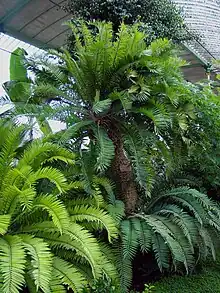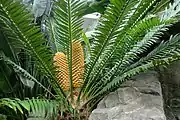| Encephalartos altensteinii | |
|---|---|
 | |
| The oldest European cycad in Lednice Greenhouse, Czech Republic. This plant predates the 1845 glasshouse and is estimated to be 300 - 500 years old. | |
| Scientific classification | |
| Kingdom: | Plantae |
| Clade: | Tracheophytes |
| Clade: | Gymnospermae |
| Division: | Cycadophyta |
| Class: | Cycadopsida |
| Order: | Cycadales |
| Family: | Zamiaceae |
| Genus: | Encephalartos |
| Species: | E. altensteinii |
| Binomial name | |
| Encephalartos altensteinii | |
| Synonyms[2] | |
| |
Encephalartos altensteinii is a palm-like cycad in the family Zamiaceae. It is endemic to South Africa. The species name altensteinii commemorates Altenstein, a 19th-century German chancellor and patron of science.[3] It is commonly known as the breadtree, broodboom, Eastern Cape giant cycad or uJobane (Zulu).[4] It is listed as vulnerable due to habitat destruction, use for traditional medicine and removal by collectors.[1]
Description


This cycad grows up to seven metres (23 ft) tall and may be branched or unbranched. The leaves are straight or curved backwards and up to three metres (9.8 ft) in length. The leaflets are rigid and fairly broad with one or both margins toothed. There are no prickles at the base of the leaf which distinguishes it from E. natalensis. There are usually two to five greenish-yellow cones up to 50 centimetres (20 in) long, the female scales covered with protuberances. The cones are poisonous to humans.[5] The seeds are scarlet and up to four centimetres (1.6 in) long.[4]
Distribution and habitat
This species is widespread in the Eastern Cape and south-western KwaZulu-Natal provinces of South Africa. It favours sites near the coast including open scrub, steep rocky slopes, evergreen forests in valleys[6] and river banks. It also occurs inland at a higher altitude in isolated sites in the Amatola Mountains.[1]
The individual growing in the Palm House at Royal Botanic Gardens, Kew, UK is considered to be the oldest potted plant in the world, having arrived there in 1775.[7] Other individuals have also reached a great age, with the one in Lednice Greenhouse, Czech Republic estimated to be 300 to 600 years old.[8][9]
References
- 1 2 3 Donaldson, J.S. (2010). "Encephalartos altensteinii". IUCN Red List of Threatened Species. 2010: e.T41908A10589725. doi:10.2305/IUCN.UK.2010-3.RLTS.T41908A10589725.en. Retrieved 19 November 2021.
- 1 2 "Encephalartos altensteinii". Plants of the World Online. Royal Botanic Gardens, Kew. Retrieved 2020-07-24.
- ↑ "Encephalartos altensteinii () description". www.conifers.org. Retrieved 2017-08-01.
- 1 2 Palmer, E. and Pitman, N. Trees of Southern Africa. Cape Town (1972).
- ↑ Deneys Reitz. Commando: A Boer Journal Of The Boer War, chapter 22, "Moss-Troopers", first published by Faber and Faber in Great Britain in 1929, ISBN 0-571-08778-7
- ↑ "Encephalartos altensteinii". plantnet.rbgsyd.nsw.gov.au. Retrieved 2017-08-01.
- ↑ Avis-Riordan, Katy. "Meet the oldest pot plant in the world". Royal Botanic Gardens Kew. Retrieved 23 June 2023.
- ↑ "Encephalartos Altensteinii in Lednice Chateau Greenhouse". Cykasy - Czech cycads. Retrieved 23 June 2023.
- ↑ Hodgkiss, R. J. "The Cycad page - Cycadaceae, Stangeriaceae, Zamiaceae". The Succulent Plant page.
External links
 Media related to Encephalartos altensteinii at Wikimedia Commons
Media related to Encephalartos altensteinii at Wikimedia Commons
